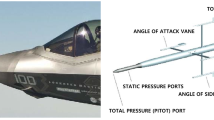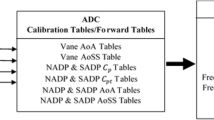Abstract
Flush Air Data Sensing System (FADS) forms a mission critical sub system in future reentry vehicles. FADS makes use of surface pressure measurements from the nose cap of the vehicle for deriving the air data parameters of the vehicle such as angle of attack, angle of sideslip, Mach number, etc. These parameters find use in the flight control and guidance systems, and also assist in the overall mission management. The FADS under consideration in this paper makes use of nine pressure ports located in the nose cap of a technology demonstrator vehicle. In flight, the air data parameters are obtained from the FADS estimation algorithm using the pressure data at the nine pressure ports. But, these pressure data will not be available, for testing the FADS package during ground simulation. So, an inverse software to FADS which estimates the pressure data at the pressure ports for a given flight condition is developed. These pressure data at the nine ports will go as input to the FADS package during ground simulation. The software is run to generate the pressure data for the descent phase trajectory of the technology demonstrator. This data is used again to generate the air data parameters from FADS algorithm. The computed results from FADS algorithm match well with the trajectory data.












Similar content being viewed by others
Abbreviations
- C:
-
Sonic velocity
- M:
-
Mach number
- \(\text{P}_{\infty }\) :
-
Free stream pressure
- Pi :
-
Incident pressure at a port
- qc :
-
Impact pressure
- \(\upgamma\) :
-
Ratio of specific heats
- \(\uprho_{0}\) :
-
Free stream density
- \(\upmu\) :
-
Dynamic viscosity
- \(\upvarepsilon\) :
-
Shape and compressibility factor
- \(\updelta \upalpha\) :
-
Angle of attack flow correction angle
- \(\updelta \upbeta\) :
-
Angle of sideslip flow correction angle
- \(\uptheta_{i}\) :
-
Flow incident angle
- \(\upalpha_{e}\) :
-
Effective angle of attack
- \(\upbeta_{e}\) :
-
Effective angle of sideslip
- \(\upalpha\) :
-
True angle of attack
- \(\upbeta\) :
-
True angle of sideslip
- \(\uplambda\) :
-
Cone angle of pressure port
- \(\upvarphi\) :
-
Clock angle of pressure port
- Cp :
-
Coefficient of pressure
- \(\text{q}_{\infty }\) :
-
Free stream dynamic pressure
- Q:
-
Identity matrix of order 9
References
S.A. Whitmore, B.R. Cobleigh, E.A. Haering, Design and Calibration of the X-33 Flush Air Data Sensing (FADS) System, NASA/TM-1998-206540 (Research Engineering, NASA Dryden Flight Research Centre, 1998), pp. 1–32
J.C. Ellsworth, S.A. Whitmore, Re-entry Air Data System for a Suborbital Spacecraft Based on X-34 Design, AIAA Paper 2007-1200
J.C. Ellsworth, S.A. Whitmore, Simulation of a flush air data system for transatmospheric vehicles. J. Spacecr. Rockets 45(4), 716–732 (2008)
T.J. Larson, P.M. Siemers, Use of Nose Cap and Fuselage Pressure Orifices for Determination of Air Data for Space Shuttle Orbiter Below Supersonic Speeds, NASA TP-1643 (1980)
T.J.. Larson, S.A. Whitmore, L.J. Ehernberger, J.B. Johnson, P.M. Siemers, Qualitative Evaluation of a Flush Air Data System at Transonic Speeds and High Angles of Attack, NASA TP-2716 (1987)
G.V. Rajeshkumar et al., Calibration of Air Data Systems Using Numerical Simulation of Supersonic Flow Over Blunt Forebody, in 20th National Convention of Aerospace Engineers (Trivandrum, 2006)
G.V. Rajesh Kumar, C.S. Harish, S. Swaminathan, M. Lal, Development of a flush air data system for a winged body re-entry vehicle, in 2nd European Conference for Aerospace Sciences (EUCASS) (Belgium, 2007)
P.M. Siemers, M. Paul, W. Henry, W.H. Martin, Shuttle Entry Air Data System (SEADS)—Flight Verification of an Advanced Air Data System Concept, AIAA 88-2104 (1988)
S.A. Whitmore, T.R. Moes, T.J. Larson, Preliminary Results from a Subsonic High of Attack Flush Air Data Sensing (HI-FADS) System. Design, Calibration and Flight Test Evaluation, NASA TM-101713 (1990)
S.A. Whitmore, A.R. Davis, M.J. Fife, Flight Demonstration of a Real Time Flush Air Data Sensing (RT-FADS) System, AIAA Paper 94-3433 (1995)
N. Remesh, M. Jayakumar, K.C. Finitha, A. Kumar, N. Shyam Mohan, S. Swaminathan, Pressure measurement sensitivity studies on a reusable launch vehicle (RLV) flush air data sensing system (FADS), in Proceedings of National Conference on Space Transportation Systems, Opportunities and Challenges (STS) (2011)
Author information
Authors and Affiliations
Corresponding author
Rights and permissions
About this article
Cite this article
Madhavanpillai, J., Dhoaya, J., Balakrishnan, V.S. et al. Inverse Flush Air Data System (FADS) for Real Time Simulations. J. Inst. Eng. India Ser. C 98, 705–713 (2017). https://doi.org/10.1007/s40032-017-0398-2
Received:
Accepted:
Published:
Issue Date:
DOI: https://doi.org/10.1007/s40032-017-0398-2




